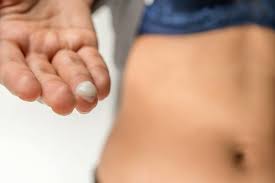Here you will know above all for the How Leucorrhea happening to Young Girls and Its Treatments. Leucorrhea, a common yet often misunderstood condition, affects many young girls during their formative years. This condition involves a white or yellowish discharge from the vagina, which can be both alarming and uncomfortable. While it is typically not a serious medical issue, understanding its causes and treatments is crucial for young girls and their caregivers. This article aims to shed light on how leucorrhea happens to young girls and the various treatment options available. Additionally, we will explore preventive measures to help manage and reduce the occurrence of this condition.
Contact us on WhatsApp if you need treatment of Leucorrhea if you have Leucorrhea problems.
How Leucorrhea happening to Young Girls and Its Treatments
Leucorrhea is a medical term used to describe a white or yellowish vaginal discharge. It is often a natural process that helps to cleanse the vagina and maintain a healthy balance of bacteria and moisture. However, when the discharge becomes excessive or is accompanied by other symptoms such as itching, burning, or a foul odor, it can indicate an underlying issue. For young girls, this condition can be particularly distressing, as they may not fully understand what is happening to their bodies.
Causes of Leucorrhea in Young Girls
Several factors can contribute to the development of leucorrhea in young girls. One common cause is hormonal changes, especially during puberty. As the body adjusts to new hormone levels, the vaginal environment may become imbalanced, leading to increased discharge. Additionally, poor hygiene practices, such as not changing underwear regularly or not wiping properly after using the toilet, can also contribute to the condition. Furthermore, infections, either bacterial or fungal, are another significant cause of leucorrhea. These infections can be the result of poor hygiene, sexual activity, or the use of irritants such as scented soaps or bubble baths.
Symptoms of Leucorrhea
The primary symptom of leucorrhea is the presence of a white or yellowish vaginal discharge. However, it is essential to note that this discharge can vary in consistency and quantity. In some cases, it may be thin and watery, while in others, it may be thick and sticky. Additionally, the discharge may be accompanied by other symptoms such as itching, burning, or a foul odor. These symptoms can be particularly uncomfortable and may cause significant distress for young girls.
Psychological Impact
The psychological impact of leucorrhea on young girls should not be underestimated. Many girls may feel embarrassed or anxious about the condition, which can affect their self-esteem and overall well-being. They may be reluctant to discuss their symptoms with parents or healthcare providers, leading to delays in seeking appropriate treatment. It is crucial for caregivers to provide a supportive and understanding environment, encouraging open communication and addressing any concerns the young girl may have.
Diagnosis of Leucorrhea
Medical Evaluation
When a young girl presents with symptoms of leucorrhea, a thorough medical evaluation is necessary to determine the underlying cause. This typically involves a detailed medical history and a physical examination. The healthcare provider may ask questions about the girl’s hygiene practices, menstrual history, and any recent changes in her health or lifestyle. Additionally, a pelvic examination may be performed to assess the condition of the vaginal tissues and check for any signs of infection or inflammation.
Laboratory Tests
In some cases, laboratory tests may be necessary to confirm the diagnosis and identify the specific cause of leucorrhea. These tests may include a vaginal swab, which can be analyzed for the presence of bacteria, yeast, or other pathogens. A urinalysis may also be conducted to rule out urinary tract infections, which can sometimes cause similar symptoms. Blood tests may be ordered if there is a suspicion of hormonal imbalances or other systemic conditions contributing to the discharge.
Treatment Options for Leucorrhea
Medical Treatments
The treatment of leucorrhea in young girls depends on the underlying cause of the condition. If an infection is identified, the healthcare provider may prescribe antibiotics or antifungal medications to eliminate the infection. In cases where hormonal imbalances are suspected, hormonal therapy may be recommended to regulate the menstrual cycle and reduce the occurrence of discharge. Additionally, topical creams or ointments may be prescribed to alleviate any itching or irritation.
Home Remedies and Lifestyle Changes
In addition to medical treatments, several home remedies and lifestyle changes can help manage and reduce the symptoms of leucorrhea. Maintaining good hygiene is crucial, including regular bathing, changing underwear daily, and avoiding the use of scented products in the genital area. It is also essential to stay hydrated and maintain a balanced diet rich in vitamins and minerals to support overall health. Some natural remedies, such as consuming yogurt or probiotics, may help restore the balance of healthy bacteria in the vagina and reduce the risk of infections.
Preventive Measures
Preventing leucorrhea involves adopting good hygiene practices and making healthy lifestyle choices. Parents and caregivers should educate young girls about the importance of proper genital hygiene, including wiping from front to back after using the toilet and wearing breathable, cotton underwear. It is also essential to avoid using irritants such as scented soaps, bubble baths, or douches, which can disrupt the natural balance of bacteria in the vagina. Regular check-ups with a healthcare provider can help monitor the girl’s health and address any concerns early on.
Homeopathic Treatment of Leucorrhea in Young Girls
Homeopathy offers a gentle and holistic approach to treating leucorrhea in young girls. This alternative medicine system focuses on stimulating the body’s natural healing processes using highly diluted substances. Homeopathic treatments are tailored to the individual’s specific symptoms and overall health, making it a personalized and patient-centered approach. Below, we will explore some of the most commonly used homeopathic remedies for leucorrhea in young girls, along with their indications and benefits.
Understanding Homeopathy
Principles of Homeopathy
Homeopathy is based on two fundamental principles: “like cures like” and the “law of minimum dose.” The first principle suggests that a substance that causes symptoms in a healthy person can, when diluted, treat similar symptoms in a sick person. The second principle emphasizes using the smallest possible dose to stimulate the body’s healing mechanisms. These principles guide the selection and preparation of homeopathic remedies.
Preparation of Homeopathic Remedies
Homeopathic remedies are prepared through a process called potentization, which involves serial dilution and succussion (vigorous shaking). This process is believed to enhance the therapeutic properties of the original substance while minimizing potential side effects. The resulting remedies are available in various forms, including pellets, tablets, and liquid solutions, and are typically administered under the tongue for optimal absorption.
Common Homeopathic Remedies for Leucorrhea
Calcarea Carbonica
Indications: Calcarea Carbonica is often recommended for girls who experience thick, milky white discharge accompanied by itching and burning. This remedy is particularly suited for those who are overweight, easily fatigued, and prone to cold hands and feet. Additionally, girls who crave sweets and have a tendency to sweat excessively, especially on the head, may benefit from this remedy.
Benefits: Calcarea Carbonica helps regulate the menstrual cycle, reduce the intensity of the discharge, and alleviate associated symptoms such as itching and burning. It also supports overall hormonal balance and enhances the body’s natural defenses against infections.
Sepia
Indications: Sepia is indicated for girls who have a yellowish or greenish discharge with a foul odor. The discharge may be accompanied by a dragging sensation in the pelvic region and a feeling of heaviness. This remedy is particularly effective for those who feel irritable, indifferent, or depressed, and who have a strong aversion to physical and emotional exertion.
Benefits: Sepia helps reduce the discharge and its unpleasant odor, while also addressing the associated emotional and psychological symptoms. It promotes overall well-being and restores vitality and energy.
Pulsatilla
Indications: Pulsatilla is recommended for girls who experience thick, creamy, or yellowish discharge that tends to vary in consistency and intensity. This remedy is particularly suited for those who are sensitive, emotional, and prone to mood swings. Girls who feel better in open air and have a strong aversion to fatty foods may benefit from Pulsatilla.
Benefits: Pulsatilla helps regulate the discharge, alleviate associated symptoms such as itching and burning, and stabilize emotional fluctuations. It also supports overall hormonal balance and improves the body’s resistance to infections.
Silicea
Indications: Silicea is indicated for girls who have a thin, watery, and foul-smelling discharge. This remedy is particularly effective for those who are delicate, easily fatigued, and prone to recurrent infections. Girls who have a tendency to sweat excessively, especially on the feet, and who are sensitive to cold may benefit from Silicea.
Benefits: Silicea helps reduce the discharge and its unpleasant odor, while also enhancing the body’s natural defenses against infections. It promotes overall health and vitality, supporting the body’s ability to heal and recover.
Borax
Indications: Borax is recommended for girls who experience a white, egg-white-like discharge accompanied by itching and burning. This remedy is particularly suited for those who are anxious, sensitive to noise, and prone to recurrent mouth ulcers. Girls who feel worse during menstruation and have a strong aversion to downward motion may benefit from Borax.
Benefits: Borax helps regulate the discharge, alleviate associated symptoms such as itching and burning, and reduce anxiety and sensitivity. It also supports overall hormonal balance and enhances the body’s resistance to infections.
Choosing the Right Remedy
Individualized Treatment
The selection of a homeopathic remedy for leucorrhea in young girls should be based on a comprehensive evaluation of the individual’s symptoms, overall health, and emotional state. A qualified homeopathic practitioner can conduct a thorough assessment and recommend the most appropriate remedy and dosage. It is essential to follow the practitioner’s guidance and avoid self-prescribing, as the effectiveness of homeopathic treatment depends on the correct remedy selection and proper administration.
Safety and Efficacy
Homeopathic remedies are generally safe and well-tolerated, with minimal risk of side effects. However, it is crucial to ensure that the remedies are sourced from reputable manufacturers and used according to the practitioner’s instructions. Additionally, homeopathic treatment should be viewed as a complementary approach and not a substitute for conventional medical care. It is essential to consult a healthcare provider for a proper diagnosis and appropriate treatment of any underlying conditions contributing to leucorrhea.
In Conclusion
Leucorrhea is a common condition that can affect young girls, causing discomfort and distress. Understanding the causes, symptoms, and treatment options is crucial for managing this condition effectively. By adopting good hygiene practices, seeking appropriate medical treatment, and providing a supportive environment, caregivers can help young girls navigate this challenging time and maintain their overall health and well-being.








